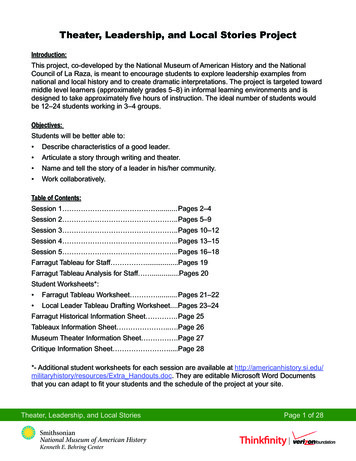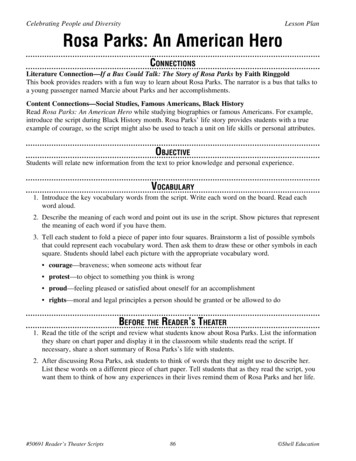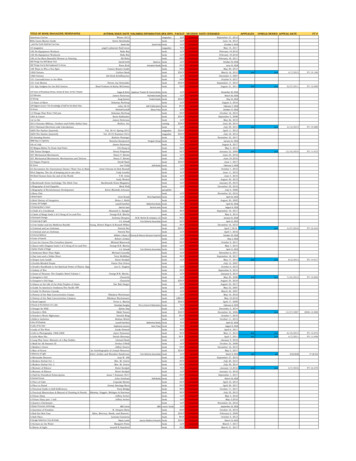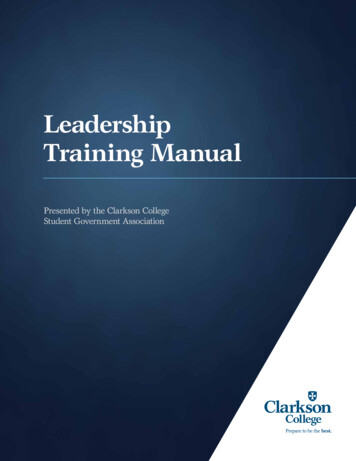
Transcription
Theater, Leadership, and Local Stories ProjectIntroduction:This project, co-developed by the National Museum of American History and the NationalCouncil of La Raza, is meant to encourage students to explore leadership examples fromnational and local history and to create dramatic interpretations. The project is targeted towardmiddle level learners (approximately grades 5–8) in informal learning environments and isdesigned to take approximately five hours of instruction. The ideal number of students wouldbe 12–24 students working in 3–4 groups.Objectives:Students will be better able to: Describe characteristics of a good leader. Articulate a story through writing and theater. Name and tell the story of a leader in his/her community. Work collaboratively.Table of Contents:Session 1 . Pages 2–4Session 2 . Pages 5–9Session 3 . Pages 10–12Session 4 . Pages 13–15Session 5 . Pages 16–18Farragut Tableau for Staff .Pages 19Farragut Tableau Analysis for Staff .Pages 20Student Worksheets*: Farragut Tableau Worksheet . Pages 21–22 Local Leader Tableau Drafting Worksheet.Pages 23–24Farragut Historical Information Sheet . Page 25Tableaux Information Sheet . .Page 26Museum Theater Information Sheet .Page 27Critique Information Sheet .Page 28*- Additional student worksheets for each session are available at urces/Extra Handouts.doc. They are editable Microsoft Word Documentsthat you can adapt to fit your students and the schedule of the project at your site.Theater, Leadership, and Local StoriesPage 1 of 28
Session 1Overview: In this session, students will experiment with two theater activities, view a video ofhistorically-based theater, and explore the characteristics of leadership.Session at a Glance: Introduction (8 minutes) Museum Theater Video and Discussion (20-35 minutes) ACTivity 1: Bring Characteristics of Leadership to Life Through Acting (10-15 minutes) Wrap-Up (1 minute)Time Spent: 39-65 minutesStaff Preparation: Watch the museum theater video (online at urces/video/torpedoes.asx ). Review the Farragut Historical Information Sheet (page 25) and Museum Theater InformationSheet (page 27). Consider watching the short video with a sample of students completing ACTivity 1, availableonline at http://www.youtube.com/watch?v U1S7z64SqN4. If you plan to use the student handouts, download the files at urces/Extra Handouts.doc and adapt them as needed. Print at least one copyper group.Staff Choices: In Part 2C: Plan whether to use the museum theater video as a whole piece (16 minutes) or in fiveacts (2-6 minutes each). If your students tend to get restless during videos, shorter acts might be agood idea. Use the suggested discussion questions in between each act. If necessary, the activitycan still be done using only acts 3 and 4 (6 minutes total). In Part 2D: If you have a computer with a projection screen and Internet, consider trying the “techoption” to create online word art with the students as they brainstorm about leadership.Classroom Set-Up: TV or projection screen with computer or DVD player Open space for students to form a circleStep-By-Step:1. Introduction:a) Over the next few sessions, we’re going to work together to learn a story about our communityand tell it through acting. Along the way, we’ll do lots of games to help us practice our acting.b) What are some of the ways that we learn stories? (television, movies, books, textbooks, comicTheater, Leadership, and Local StoriesPage 2 of 28
books, out loud from relatives, friends, and family, online, newspapers, theater, dance, puppetshows)2. Museum Theater Video and Discussiona) Acting (in movies, on TV, in a theater) can be a powerful way to tell a story because it includesreal people pretending that the story is happening to them. Some museums use acting as a wayto tell stories about the past. Let’s take a look at an example of an actor pretending to be a mannamed David Farragut. David Farragut lived about 150 years ago, so the actor is pretending it’sa long time ago and that his audience is also from 150 years in the past.c) Watch the video together eo/torpedoes.asx).Suggested Discussion Questions (if you choose to watch the video in acts)- Act 1 ources/video/torp1.asx):- What qualities do you think make a good leader?- What hints do you see or hear that tell you something about David Farragut?- Act 2 ources/video/torp2.asx):- What activities or ideas are you passionate about?- Retell the story the actor told about the young sailor who wouldn’t work hard.- Act 3 ources/video/torp3.asx):- What reasons motivated Farragut to fight for the North during the Civil War?- Talk about a time when you had to make a hard decision like Farragut.- Act 4 ources/video/torp4.asx):- What were some of the most memorable words in Farragut’s speech to hismen during the Battle?d) After the video, discuss:1) Just from watching the video, what hints do we have that the actor is pretending to be in thepast? (costume, very formal style of speaking)2) The actor playing Farragut was very specific about four specific qualities of a good leader.Can you remember any of them? ( passion and commitment, willingness to work hard,strength of character, and perseverance and courage) What examples did he use to talkabout those qualities?Note to staff: If students struggle with these concepts, consider discussing these definitions,to have a common understanding. passion- intense liking or desire for or devotion to some activity or concept commitment- the attitude of someone who works very hard to do or support something willingness to work hard- hard work that is accepted or done by choice or withoutreluctance strength of character- the good qualities of a person that usually include moral or emotionalTheater, Leadership, and Local StoriesPage 3 of 28
strength, honesty, and fairness perseverance- the quality that allows someone to continue trying to do something eventhough it is difficult courage- the ability to do something that you know is difficult or dangerous3) Do you agree or disagree that those are important qualities of a good leader? Who wouldyou say are good leaders and how would you describe them? Write these qualities on theboard as students list them.Tech-option: If you have access to computers, you could consider creating Wordle word art(http://wordle.net) with your qualities. This art could be used just during ACTivity 2, or it couldbe saved to use as the background for your theater performance or on the flyer promoting theperformance. If the technology is easily available, consider doing the wordle in class. If not,consider asking a tech-savvy student to work on the wordle after class or during computertime.4) Do you remember how old Farragut was when he was first put in charge of a ship? (10years old) Do you think a leader must be a certain age?5) What were the most memorable parts of the story he told? What parts were most importantfor the audience to remember?3. ACTivity 1: Bring Characteristics of Leadership to Life Through Actinga) Have students gather in a circle in the center of the room and face away from the circle.b) Name out a characteristic from the board and have students take the form of of eachcharacteristic.c) After running through each of the characteristics, have students form pairs. With each pair, onlyone of the students will initially take the pose, then the other student in the pair will mirror thepose. Then switch, so the student who made the pose is now mirroring his/her partner.Note to staff: Consider either stretching out this thought or moving quickly through, depending on yourclass. If your students know each other well, consider having students name qualities thattheir classmates hold. For example, “Katie is perseverant. She is good at helping me withmy math worksheets no matter how many times she has to explain the answers to me.”4. Wrap-UpDuring the next few sessions, we’ll learn more about a leader from our own community, write aperformance to go with his or her story, and then we’ll perform the story. Our final project will bea theater presentation about a leader, like the video we watched today.Tonight, talk with yourfamily about the characteristics of a leader we discussed and listed on the board. See if yourfamily agrees on these qualities, and if they have any suggestions of “good leaders” from yourcommunity. Or just think about whether you know of any local leaders you think are interesting.Theater, Leadership, and Local StoriesPage 4 of 28
Session 2Overview: In this session, students will experiment with two theater activities, get an introduction totableaux style theater, and identify and research a local leader.Session at a Glance: Introduction (1 minute) ACTivity 2: Human Machine (10 minutes) Identifying a Local Leader (10 minutes) Researching a Local Leader (15-20 minutes) ACTivity 3: Farragut in Tableaux Theater Style (20 minutes) Wrap-Up (1 minute)Time Spent: 57–67 minutesStaff Preparation: Plan working groups for your students that will stay together over the next four sessions. Review the Farragut Tableau for Staff (page 19) and Tableaux Information Sheet (page 26).Consider watching an example tableau with the fairytale “Jack and the Beanstalk,” available onlineat http://www.youtube.com/watch?v ePQHqn8rcOc. Print copies of the Farragut Tableau Worksheet (pages 21–22). Print at least one copy per group. Consider watching the short videos with a samples of students completing ACTivity 2, availableonline at http://www.youtube.com/watch?v J-NfJBECWYM, and ACTivity 3, available online athttp://www.youtube.com/watch?v a6UldiG53BY. If you plan to use the student handouts, download the files at urces/Extra Handouts.doc and adapt them as needed. Print at least one copyper group.Staff Choices: For Part 3, students may need additional support in identifying one or more local leader. Considerone or more of these brainstorming ideas: Ask the principal of your school or director of your community center to speak with the studentsand respond to the prompt questions. If you have the time and resources, consider asking for a visit from someone from the localhistorical society or history museum. The speaker might recommend a specific local leaderand/or offer suggestions for research sources. Find the website of your local newspaper or review a printed copy of the newspaper. Are thereany names that seem to appear over and over again?For Part 4, students will need access to research sources, such as a library, computers withInternet, and/or local newspapers. Decide which research sources can be made available for yourclass.Theater, Leadership, and Local StoriesPage 5 of 28
For Part 5 C and D, if you think your students will struggle with the idea of tableaux theater,consider sharing a sample tableau with them, available online at XX and XX. It tells the story of“Jack and the Beanstalk.” For Part 5 G and H, students use the idea of a plot diagram to understand action in a story.Depending on the reading and interest levels of the students, consider skipping this portion, butalso remember to skip the plot diagram discussions later on.Classroom Set-Up: Research sources (such as a library, computers with Internet, and/or local newspapers) Open space for students to act in together (optional) Digital projector to share sample tableauStep-By-Step:1. Introduction:Today we’ll start to focus our learning about leaders and theater. We’ll select a local leader thatwill be the focus of our projects and we’ll learn a kind of “frozen” theater called tableaux (tabl-loh)that we’ll use for our project.2. ACTivity 2: Human Machine:a) Instruct one student to go to the center of the stage area and begin to move their body asthough it is part of a machine. The student’s movement should be repetitive and continuous.b) One by one, add students to the “human machine.” As students add themselves to the machine,they should perform actions that connect with, balance, or respond to the actions of themachine. For example, if one student is raising and lowering one knee, the next student mightmirror the raising and lowering with an opposite knee at the same pace, balance the movementby raising and lowering a hand at the same pace or twice as fast, or connect with the movementby acting as if (without contact) the first student’s knee is pushing the second student forward.c) Encourage students to move without touching each other and complete the exercise withseriousness.d) After trying to activity with the entire class, try breaking the students into smaller groups.Experiment with the ideal size for group collaboration. Once groups have proven themselvesable to do the Human Machine together, assign them as a single group for research and therest of the project.Note to Staff: The goal of this ACTivity is to encourage group awareness, think about groupdynamics, and build focus with the students. Also consider pointing out to students that storiesare made up of many moving parts that need to come together as a coherent unit, like theirHuman Machine was built of many parts but worked together, as well.Theater, Leadership, and Local StoriesPage 6 of 28
3. Have students break into groups to identify a leader connected to the story of your community. Theideal group will include 4 to 6 students. Ideal classes will include 3 or 4 tableau groups.a) Prompts: Try to name some important events in your community’s history. Start with the recent pastand then think further back in history. Was any one person an important leader in helpingyour community through that milestone? Find out the names of your mayor, governor, Congressional representatives and Senators. Now think about other people who are leaders in your community. Is your principal a goodleader? Who is the leader of your community center? Does your community have a sportsteam? Who is its coach? Have you ever met someone important to your community? Did you think s/he was a goodleader?Note to Staff: Depending on the size of your community, you might want to consider your“larger” community, such as the rest of your county or state, for ideas.If the students are struggling to find a local leader or are very excited about a national orinternational leader, don’t be afraid to follow their enthusiasm.b) Other sources of ideas: Ask the principal of your school or director of your community center to speak with thestudents and respond to the prompt questions. If you have the time and resources, consider asking for a visit from someone from the localhistorical society or history museum. The speaker might recommend a specific local leaderand/or offer suggestions for research sources. Find the website of your local newspaper or review a printed copy of the newspaper. Arethere any names that seem to appear over and over again?4. Researching Community Leaders:a) Encourage students to begin researching the local leaders they have selected. Differentsources of information could be useful depending on how famous the leader is or how recentlythe leader acted.b) Recommended Sources of Information:Web Local newspaper web site Local public radio station web site Homepages for government institutions, such as your city’s web page, http://senate.gov/, orhttp://house.gov/Note to Staff: A basic Internet search can turn up a lot of resources, but it can be difficult toknow what resources are valuable. Here are a few tips to consider: Look at the URL. The domain (.gov, .com, .edu, etc.) says a lot about who is publishingTheater, Leadership, and Local StoriesPage 7 of 28
the resource. Be careful with .com sites since they are likely trying to sell an idea orproduct, and be especially careful with sites that include a person’s name since anindividual has little to lose from posting incorrect information. How recently was it updated? Who is the author? Has he or she been published anywhere else? Does the informationabout her suggest that she is an expert on this topic? For more tips, an in-depth guide to evaluating web resources is available from theUniversity of California at Berkeley ternet/Evaluate.html).Paper Local newspaper Library booksInterviews With the leader himself/herself With someone who has met the leader With someone who was inspired by the leader and knows something about him/herNote to Staff: Encourage students to take written notes and photocopy or print sources.Collect all of the notes at the end of the session so nothing gets lost between sessions.5. ACTivity 3: Let’s remember the story of David Farragut: there are many ways that his story could beacted out. In the video, the actor was alone, he spoke lines out loud, and he sometimes moved orgestured like he was a part of the story he was telling. For example, when he was telling the storyabout the young sailor who didn’t work hard, he pulled out a chair to represent the young sailor,and retold the story like it was all happening again with two people. Let’s try acting out the story ofDavid Farragut in a method called tableau (tab-loh). I’ll read a story out loud and you will recreatethe story in frozen scenes without words,sounds, or movement. There will be six scenes in thistableau presentation, and each one will have a frozen scene to go with it.a) First, just read through the Farragut Tableau for Staff (page 19) and ask students to listen.b) Hand out the Farragut Tableau Worksheet (pages 21–22). Have students underline keywordsand/or sketch what each scene would look like if it was a comic strip.c) Ask for 4-5 volunteers to take part in acting out this story in tableaux-style theater.d) For this exercise, people can take on one or more role (so sometimes they can be Farragut,sometimes they can be the “bad guys” and sometimes there will be more than one personacting as each part. Now, after I finish each chunk of the story, you should take on a posetogether that shows what is happening.Note to Staff: If students are struggling, try suggesting the underlined words in the “for Staff”version of the tableau (Page 19).Theater, Leadership, and Local StoriesPage 8 of 28
e) Let’s talk about that first run through. Ask your volunteers: What was your favorite part to act out? What part was hard to act out?How could we work together to make the hard parts a little easier? Ask your audience: What part or parts do you think did a good job telling the story throughposes? Do you have specific recommendations for ways to improve other parts?f) Repeat the activity, considering the discussion from 5D.g) (optional) Organize portions of the story into a plot diagram, similar to the format of ractives/plot-diagram/. Let’s figure out how these chunks of story fit together to build excitement. A plot diagramformat will help us. Has anyone seen one of these before? The line represents the energyin the story. The beginning of the story is on the left side, and the end of the story is on theright side. At first, we need to learn the basics about this story. Which parts of the tableau fit there? Then it gets exciting and starts to move up the line. Which parts of the tableau are exciting?Which one is the most exciting? After the most exciting part, things start to calm down. Which parts of the tableau fit here?h) (optional) Knowing how the different parts of the story fit together to form an exciting plot, actout each part as a tableau once more. Try to make the different parts of the story more or lessenergetic, depending on its place in the plot diagram.6. Conclusion:Now that we’ve learned this new way of acting and we know about the story of a local leader, we’llwork together to tell that story through acting.Theater, Leadership, and Local StoriesPage 9 of 28
Session 3Overview: In this session, students will revisit the model tableau, write and practice their local leadertableaux, and hone their acting skills with another performing exercise.Session at a Glance: Introduction (9 minutes) Writing the Local Leader Tableau (25-35 minutes) ACTivity 4: Emotion Party (10 minutes) Practice Local Leader Tableaux (10-30 minutes) Wrap-Up (1 minute)Time Spent: 55-85 minutesStaff Preparation: If you discussed plot diagrams during Session 2 and plan to continue using them in Session 3,review the plot diagram format used in Session 2 and the Farragut Tableau Analysis (page 20). If you plan to use the student handouts, download the files at urces/Extra Handouts.doc and adapt them as needed. Print at least one copyper group.Staff Choices: Plan who will be in the audience for the Session 5 performance. Consider inviting: Parents, family, friends, and other caregivers (if they tend to be available during the time ofyour performance) Older or younger students from the same school or community center Staff and teachers from the same school or community centerConsider watching the short video with a sample of students completing ACTivity 4, availableonline at http://www.youtube.com/watch?v YYVQv1UDxS8.Classroom Set-Up: Open space for students to act in together If you will be doing the tech option for part 2, make one or more computer available for eachgroup. Consider creating a wall chart of the text of the Sample Farragut Tableau, writing the text on theblackboard, or projecting it on a wall for students to use as a reference.Step-By-Step:1. Introductiona) Ask the groups to describe the most exciting parts of the local leader stories researched in yourclass.Theater, Leadership, and Local StoriesPage 10 of 28
b) Have students draw a comic strip style scene for that part of their local leader stories.c) Have each group report out on their “most exciting” scenes. Compare the scenes across localleaders and to the Farragut tableau.2. Now you’ll work together to bring the story of your community leaders to life through an excitingtableau.a) (optional) Using the plot diagram format from the Session 2, have each tableau group createtheir own plot diagram for the story of their local leader. Identify the beginning, middle, and endof the story they are telling.b) Encourage students to consider the characters and settings involved at each point on the plotdiagram. If students are struggling, consider using the tech option or the prompt questionsbelow.Setting: You don’t need an elaborate background to describe a setting. You’ll just need to tellthe audience about the setting through actions or in your narration. Narration: Do you want to include all of the setting details at once, toward the beginning?For example, “The year is 2008. The place is 150 Main Street, at the Liberty School.” Or doyou want to add them as hints throughout the performance. For example, “In 2008, CathyTreehorn was the principal of a school. She taught at that school on Main Street for 10years.” Actions: Can you use mime (acting without words or props) to tell the audience about yoursetting? For example, pretend to pick vegetables if your setting is a farm, wipe the sweatfrom your forehead if your setting is hot, or use a very formal posture if your setting is at afancy party.Character: Most of your character’s traits and actions will be conveyed through narration andtableau poses. Characteristics or actions that are hard to act out can be described in the narration. Characteristics or actions that are really important to the story should be in both thenarration and in the tableau poses.Tech Option: Multiple students who are working on the same leader should work togetherto complete the parts of the Drama Diagram (character, setting, conflict, and resolution) fromRead Write Think /student-interactives/drama-30012.html).The Drama Diagram can be completed as interactive diagrams online that students can addtext to and print, or they can be printed and completed by hand.As students work on the parts of the Drama Diagram, have them brainstorm ways to conveythose points of the story through action/poses AND words.c) As students begin to write their narration, encourage them to consider the following tips: Keep each scene to approximately four to six sentences. Try to have at least one scene for the beginning, middle, and end parts of the story. You don’twant to cut off any important details at the beginning or leave your audience wondering aboutthe ending.Theater, Leadership, and Local StoriesPage 11 of 28
Keep each tableau to about five or six scenes, but definitely no more than ten scenes.Otherwise it can get hard to remember what poses happen in which scenes.Note to Staff: If students have more scenes than they can handle, suggest combining scenesthat don’t have much action in them. For example, a scene that mostly defines the setting(such as Scene 1 in the Farragut Tableau), could be combined with a scene that has moreaction. The acting students would mostly focus on portraying the actions in the scene, and thenarrator would describe the setting outloud for the audience.d) Let’s take a break from all our writing to do another theater exercise. Shifting gears a little bitwill help us to think fresh about our local leader tableaux.3. ACTivity 4: Emotion Party Acting ExerciseBring the class together for an “emotion party,” where each guest at the imaginary party has astrong emotion that was included in their local leader tableau. One student begins as the host of aparty. S/he expresses an emotion from his/her local leader tableau. The next student comes to theparty, knocking on the door (real or imaginary), talking to the host, and acting out an emotion fromhis/her local leader tableau. If the guest has the same emotion as the host, then both studentscontinue with the same emotion. If the guest is a different emotion, then the host mirrors theemotion of the guest as they talk. Continue adding more guests. Each guest brings an emotionand changes the mood of the host and other guests when they enter the party.Note to Staff: Students can enter the party one at a time or as pairs or small groups. If theyenter as pairs, both new guests act out the same emotion.4. Before we break into our groups again, let’s decide on a narrator for each group’s tableau. Selectthe narrator(s).Note to Staff: More than one student in each group might want to be the narrator. This isultimately a staff decision. Here are some options to consider: See if both students could take turns being the narrator, with one reading the first half of thenarration and the other reading the second half. If the students are working in very smallgroups, two narrators might not leave enough other performers. Have students persuade staff by writing three reasons that s/he should be the narrator.5. Have groups practice their tableaux. Encourage the students to refine their narration and actingas they practice. Consider circulating to observe and coach each group, or ask one studentto step out of each group and assist another group as a coach. Coaches should offer specificsuggestions, name specific parts that worked well, and be mindful that the tableaux are all “worksin-progress”6. Conclusion:If appropriate, remind students to invite friends, family, or other supporters to the performance.Theater, Leadership, and Local StoriesPage 12 of 28
Session 4Overview: In this session, students will hone their silent performance skills with two acting exercisesand collaboratively refine their local leader tableaux using theater critique techniques.Session at a Glance: Introduction (1 minute) ACTivity 5: Wordless Telephone (10 minutes) Practice Local Leader Tableaux (10 minutes) ACTivity 6: Walking Around the Room (5-10 minutes) Critique (20-30 minutes) Wrap-Up (1 minute)Time Spent: 47-62 minutesStaff Preparation: Review the Critique Information Sheet (Page 28). Consider watching the short videos with a samples of students completing ACTivity 5, availableonline at http://www.youtube.com/watch?v 1Hp3lWzeQfw, and ACTivity 6, available online athttp://www.youtube.com/watch?v PV0TC0qzZYg. If you plan to use the student handouts, download the files at urces/Extra Handouts.doc and adapt them as needed. Print at least one copyper group.Staff Choices: Part 4 (ACTivity 6, Walking Around the Room) is optional. It can be a great exercise to getstudents thinking about body language, but if you have limited space or time, feel free to skip thisACTivity. In Part 5C, students will be offering each other critique comments that are kind, specific, andhelpful. If you think your students might have difficulty developing “good critique,” consider askingstudents to write their critique and submit to the staff. You can then filter the critique and readonly those that match the criteria of “good critique.” The drawback to this method is that studentswould then feel less responsibility to treat others as they would like to be treated, since the staffwill be filtering.Classroom Set-Up: Open space for students to act in together and for students to act in small groups.Theater, Leadership, and Local StoriesPage 13 of 28
Step-By-Step:1. Introduction:Now that we have a good idea of what our local leader tableaux will be about, let’s spend thissession sharpening our acting skills and working together to improve everyone’s tableaux.2. ACTivity 5: Wordless “Telephone”Thi
books, out loud from relatives, friends, and family, online, newspapers, theater, dance, puppet shows) 2. Museum Theater Video and Discussion a) Acting (in movies, on TV, in a theater) can be a powerful way to tell a story because it includes real people pretending that the sto










